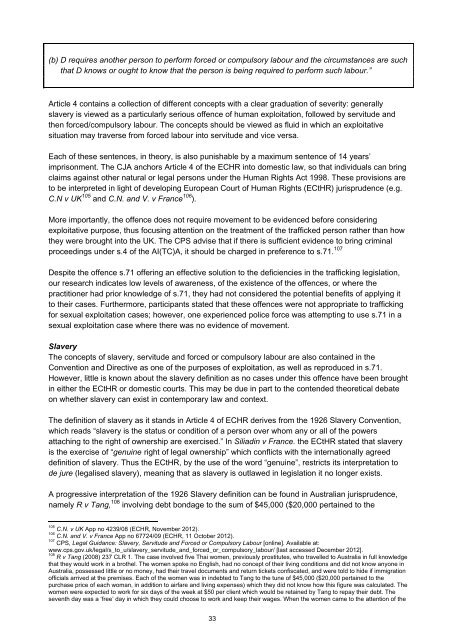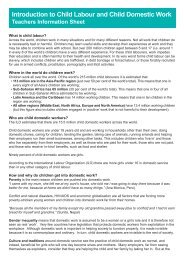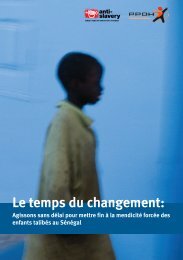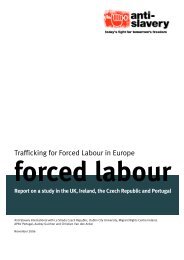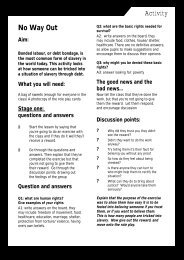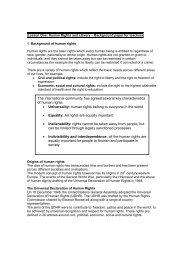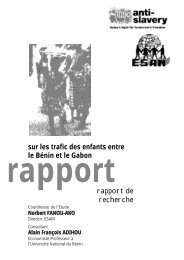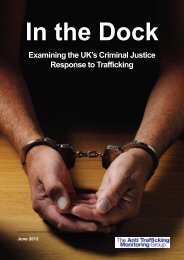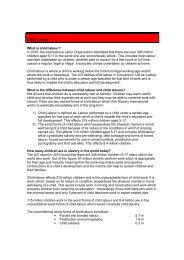moved within <strong>the</strong> UK for exploitation. <strong>In</strong> sum, <strong>the</strong>se misconceptions may, in part, be due to <strong>the</strong> CPSguidance remaining silent on <strong>the</strong> interpretation of <strong>the</strong> term “within”.Trafficking as movement?The UK’s interpretation of <strong>the</strong> Convention and <strong>the</strong> Directive’s definition is predisposed to tyingtrafficking to movement which is demonstrated by <strong>the</strong> use of <strong>the</strong> words arrival, entry, travel anddeparture. The focus on movement suggests that <strong>the</strong> period, some nine years ago, in which both <strong>the</strong>SOA and AI(TC)A were enacted, reflects <strong>the</strong> UK’s understanding of trafficking at that time. However,our understanding of trafficking has evolved and knowledge of <strong>the</strong> trafficking definition and thislegislation has become more sophisticated.Unfortunately <strong>the</strong> o<strong>the</strong>r acts contained in <strong>the</strong> international trafficking definition, 100 such as receiving orharbouring <strong>the</strong> trafficked person have been discounted. <strong>In</strong>cluding <strong>the</strong>se in <strong>the</strong> UK’s traffickinglegislation may have served, where evidence is lacking from o<strong>the</strong>r countries, to show <strong>the</strong> continualintention to exploit, from <strong>the</strong> facilitator or assister of movement to incorporate <strong>the</strong> final person in <strong>the</strong>network chain who ultimately exploits <strong>the</strong> trafficked person’s labour or services. The “harbouring andreceipt of persons” in <strong>the</strong> Convention and Directive’s definition operates to bring not just <strong>the</strong> process(recruitment, transportation, transfer) but also <strong>the</strong> end situation or product of trafficking within <strong>the</strong>scope of <strong>the</strong> definition. 101 These terms function to widen <strong>the</strong> reach of <strong>the</strong> definition to extend criminalliability to, “not just recruiters, brokers, and transporters but also owners and managers, supervisors,and controllers of any place of exploitation such as bro<strong>the</strong>ls, farms, factories, medical facilities, orhouseholds.” 102The use of “harbouring or reception of persons” within domestic legislation is supported by <strong>the</strong>European Commission: “interpretations of <strong>the</strong> Trafficking Protocol that concentrate on <strong>the</strong> process ofbringing a person into exploitation, ra<strong>the</strong>r than <strong>the</strong> final forced exploitation that <strong>the</strong>y face, are in <strong>the</strong>irnature flawed and limited. There is serious deficiency in <strong>the</strong> concept of trafficking if it focuses solely on<strong>the</strong> process of bringing ano<strong>the</strong>r person into a situation of exploitation and does not address <strong>the</strong> use offorced labour or services … where this has not been preceded by <strong>the</strong> o<strong>the</strong>r elements stipulated in <strong>the</strong>definition.” 103The current trafficking definition can be said to contain a two-pronged test, firstly requiring movementwhich acts as a filter before <strong>the</strong> actual exploitation is determined; however, constructing <strong>the</strong> traffickingdefinition as such was not <strong>the</strong> intention of <strong>the</strong> drafters of <strong>the</strong> two European instruments. Moreover,<strong>the</strong>re are concerns that this confusion may result in poor NRM referrals, where First Responders mayfocus <strong>the</strong>ir decisions too heavily on <strong>the</strong> aspect of movement and <strong>the</strong>refore this may equate to fewerreferrals.Coroners and Justice Act (CJA) 2009S.71 of <strong>the</strong> CJA entered into force on 6 April 2010 and embeds into UK domestic law <strong>the</strong> provisions ofArticle 4 of <strong>the</strong> ECHR. It was introduced to reflect <strong>the</strong> occurrence of forced labour outside of <strong>the</strong>trafficking framework and bringing <strong>the</strong> UK in line with <strong>the</strong> Siliadin v France judgement, 104 whereFrance was criticised for <strong>the</strong> lack of a criminal offence of forced labour and servitude. S.71 reads:“(1) (a) D holds ano<strong>the</strong>r person in slavery or servitude and <strong>the</strong> circumstances are such that D knowsor ought to know that <strong>the</strong> person is so held, or100The Palermo Protocol, European Convention and EU Directive.101Gallagher, supra note 80, p.30.102Ibid.103European Commission, Report of <strong>the</strong> Experts Group on Trafficking in Human Beings (December 2004), p. 46.104Siliadin v France App no 73316/01 (ECHR, 26 July 2005).32
(b) D requires ano<strong>the</strong>r person to perform forced or compulsory labour and <strong>the</strong> circumstances are suchthat D knows or ought to know that <strong>the</strong> person is being required to perform such labour.”Article 4 contains a collection of different concepts with a clear graduation of severity: generallyslavery is viewed as a particularly serious offence of human exploitation, followed by servitude and<strong>the</strong>n forced/compulsory labour. The concepts should be viewed as fluid in which an exploitativesituation may traverse from forced labour into servitude and vice versa.Each of <strong>the</strong>se sentences, in <strong>the</strong>ory, is also punishable by a maximum sentence of 14 years’imprisonment. The CJA anchors Article 4 of <strong>the</strong> ECHR into domestic law, so that individuals can bringclaims against o<strong>the</strong>r natural or legal persons under <strong>the</strong> Human Rights Act 1998. These provisions areto be interpreted in light of developing European Court of Human Rights (ECtHR) jurisprudence (e.g.C.N v UK 105 and C.N. and V. v France 106 ).More importantly, <strong>the</strong> offence does not require movement to be evidenced before consideringexploitative purpose, thus focusing attention on <strong>the</strong> treatment of <strong>the</strong> trafficked person ra<strong>the</strong>r than how<strong>the</strong>y were brought into <strong>the</strong> UK. The CPS advise that if <strong>the</strong>re is sufficient evidence to bring criminalproceedings under s.4 of <strong>the</strong> AI(TC)A, it should be charged in preference to s.71. 107Despite <strong>the</strong> offence s.71 offering an effective solution to <strong>the</strong> deficiencies in <strong>the</strong> trafficking legislation,our research indicates low levels of awareness, of <strong>the</strong> existence of <strong>the</strong> offences, or where <strong>the</strong>practitioner had prior knowledge of s.71, <strong>the</strong>y had not considered <strong>the</strong> potential benefits of applying itto <strong>the</strong>ir cases. Fur<strong>the</strong>rmore, participants stated that <strong>the</strong>se offences were not appropriate to traffickingfor sexual exploitation cases; however, one experienced police force was attempting to use s.71 in asexual exploitation case where <strong>the</strong>re was no evidence of movement.SlaveryThe concepts of slavery, servitude and forced or compulsory labour are also contained in <strong>the</strong>Convention and Directive as one of <strong>the</strong> purposes of exploitation, as well as reproduced in s.71.However, little is known about <strong>the</strong> slavery definition as no cases under this offence have been broughtin ei<strong>the</strong>r <strong>the</strong> ECtHR or domestic courts. This may be due in part to <strong>the</strong> contended <strong>the</strong>oretical debateon whe<strong>the</strong>r slavery can exist in contemporary law and context.The definition of slavery as it stands in Article 4 of ECHR derives from <strong>the</strong> 1926 Slavery Convention,which reads “slavery is <strong>the</strong> status or condition of a person over whom any or all of <strong>the</strong> powersattaching to <strong>the</strong> right of ownership are exercised.” <strong>In</strong> Siliadin v France. <strong>the</strong> ECtHR stated that slaveryis <strong>the</strong> exercise of “genuine right of legal ownership” which conflicts with <strong>the</strong> internationally agreeddefinition of slavery. Thus <strong>the</strong> ECtHR, by <strong>the</strong> use of <strong>the</strong> word “genuine”, restricts its interpretation tode jure (legalised slavery), meaning that as slavery is outlawed in legislation it no longer exists.A progressive interpretation of <strong>the</strong> 1926 Slavery definition can be found in Australian jurisprudence,namely R v Tang, 108 involving debt bondage to <strong>the</strong> sum of $45,000 ($20,000 pertained to <strong>the</strong>105C.N. v UK App no 4239/08 (ECHR, November 2012).106C.N. and V. v France App no 67724/09 (ECHR, 11 October 2012).107CPS, Legal Guidance: Slavery, Servitude and Forced or Compulsory Labour [online]. Available at:www.cps.gov.uk/legal/s_to_u/slavery_servitude_and_forced_or_compulsory_labour/ [last accessed December 2012].108R v Tang (2008) 237 CLR 1. The case involved five Thai women, previously prostitutes, who travelled to Australia in full knowledgethat <strong>the</strong>y would work in a bro<strong>the</strong>l. The women spoke no English, had no concept of <strong>the</strong>ir living conditions and did not know anyone inAustralia, possessed little or no money, had <strong>the</strong>ir travel documents and return tickets confiscated, and were told to hide if immigrationofficials arrived at <strong>the</strong> premises. Each of <strong>the</strong> women was in indebted to Tang to <strong>the</strong> tune of $45,000 ($20,000 pertained to <strong>the</strong>purchase price of each woman, in addition to airfare and living expenses) which <strong>the</strong>y did not know how this figure was calculated. Thewomen were expected to work for six days of <strong>the</strong> week at $50 per client which would be retained by Tang to repay <strong>the</strong>ir debt. Theseventh day was a ‘free’ day in which <strong>the</strong>y could choose to work and keep <strong>the</strong>ir wages. When <strong>the</strong> women came to <strong>the</strong> attention of <strong>the</strong>33
- Page 1 and 2: In the DockExamining the UK’s Cri
- Page 3 and 4: AcknowledgementsThis report was mad
- Page 5 and 6: PrefaceIn May 2009, a group of nine
- Page 7 and 8: Misconceptions around exploitation
- Page 9 and 10: Acronyms and abbreviations frequent
- Page 11 and 12: Executive SummaryIn the Dock is The
- Page 13 and 14: Furthermore, the current legislatio
- Page 15 and 16: The ATMG was made aware of some cas
- Page 17 and 18: • Introduce mandatory child-speci
- Page 19 and 20: • The UK’s ability to meet the
- Page 21 and 22: Traffickers’ primary motivation i
- Page 23 and 24: • Money launderers - turn profits
- Page 25 and 26: out to perpetuate the exploitative
- Page 27 and 28: [their] own enslavement” is as fu
- Page 29 and 30: Chapter 2: UK Anti-Trafficking Legi
- Page 31 and 32: nationals who commit trafficking of
- Page 33: Like the SOA, the “act” element
- Page 37 and 38: Forced or compulsory labourThe defi
- Page 39 and 40: ConclusionAs a consequence of the s
- Page 41 and 42: concerningly, the number of convict
- Page 43 and 44: women who were recruited in Poland
- Page 45 and 46: Chapter 4: Identifying trafficking
- Page 47 and 48: Misconceptions around exploitationT
- Page 49 and 50: espond inadequately to a trafficked
- Page 51 and 52: multi-agency teams was described by
- Page 53 and 54: Josie Connors. 179 In summary, inte
- Page 55 and 56: defending a trafficked person for f
- Page 57 and 58: “[B]ecause the NRM decision is on
- Page 59 and 60: PTSD. 196 A Consultant Psychiatrist
- Page 61 and 62: etween the client and the police, i
- Page 63 and 64: Regular communication needs to be s
- Page 65 and 66: Priority planningA particular issue
- Page 67 and 68: Chapter 6: Multi-agency and interna
- Page 69 and 70: canvassing for tarmacking opportuni
- Page 71 and 72: Despite this, it would appear that
- Page 73 and 74: Good practice - Operation Golf 229O
- Page 75 and 76: Chapter 7: Criminal proceedingsThe
- Page 77 and 78: Law enforcement working on the case
- Page 79 and 80: trafficking require particular unde
- Page 81 and 82: JuryPractitioners suggested that th
- Page 83 and 84: years”. 258 Ambiguity within the
- Page 85 and 86:
officer stated that not all judges
- Page 87 and 88:
jurors to be assisted with expert e
- Page 89 and 90:
Good feedback was received from sem
- Page 91 and 92:
The Convention does recognise that
- Page 93 and 94:
Another option for trafficked victi
- Page 95 and 96:
There are two models with respect t
- Page 97 and 98:
1. Is there clear evidence that the
- Page 99 and 100:
decision can be taken into account
- Page 101 and 102:
also entails being “alert to the
- Page 103 and 104:
In some cases concerns were even ra
- Page 105 and 106:
Chapter 9: Prosecuting child traffi
- Page 107 and 108:
However, many children are not refe
- Page 109 and 110:
trafficking”. 352 It states: “W
- Page 111 and 112:
Previous research has found that th
- Page 113 and 114:
children as well as assisting in pr
- Page 115 and 116:
Child trafficking trainingThere is
- Page 117 and 118:
were too traumatic to involve them
- Page 119 and 120:
committed by a child whilst in a co
- Page 121 and 122:
• Introduce mandatory child-speci
- Page 123 and 124:
IdentificationThe PSNI is the main
- Page 125 and 126:
participants suggest that this is b
- Page 127 and 128:
The PPS stated that the reasons for
- Page 129 and 130:
this research was aware of potentia
- Page 131 and 132:
convictions of traffickers prosecut
- Page 133 and 134:
Possibly in response to certain hur
- Page 135 and 136:
espectively. In addition to custodi
- Page 137 and 138:
Conclusion and RecommendationsThe A
- Page 139 and 140:
CRIMINAL PROCEEDINGS• Ensure that
- Page 141 and 142:
Crown Prosecution Service, Legal Gu
- Page 143 and 144:
Herman. J. Trauma and Recovery: The
- Page 145 and 146:
Annex I: Trafficking and other form
- Page 147 and 148:
(a) on summary conviction, to impri
- Page 149 and 150:
(b) which country is the country of
- Page 151 and 152:
2009 Istvan Kalocsai (Snr)MetS.57 o
- Page 153 and 154:
2009 causing actual bodily harm, su
- Page 155 and 156:
Skirmantas Kvedaras Feed, 2010 Rape
- Page 157 and 158:
2012 Ahdel Ali (24)Mubarek Ali (29)
- Page 159 and 160:
Annex III: The CPS’s Seven Stages
- Page 161 and 162:
159


